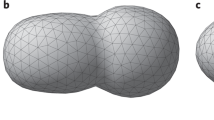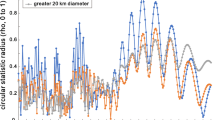Abstract
IN the more or less popular accounts which have recently been given of Prof. Arrhenius' theory of cometary tails and the auroræ, it is generally stated that the smaller the diameter of the corpuscle upon which the light is falling the greater the excess of light-pressure over gravitational force. This explanation, however, holds only so long as the diameter is greater than the wave-length of light. If the diameter becomes of the same order as the wave-length, the ratio between light-pressure and gravitation follows an entirely different law. This has recently been demonstrated by Prof. Schwarzschild by an exhaustive mathematical treatment of the question in a paper entitled “Der Druck des Lichtes auf kleine Kugeln und die Arrhenius'sche Theorie der Cometenschweife” (Sitzungsberichte der k. b. Academie der Wissenschaften zu München, 1901, Heft iii.). The conclusions arrived at in this paper are of considerable importance in so far as they show that the effect of gravitation is exceeded by that of the pressure of light only so long as the diameter of the corpuscle is greater than about 0.07.μ For this limiting value the two forces are exactly balanced; but for smaller values of the diameter the light-pressure becomes rapidly less, so that it is then always exceeded by gravitation. It would appear from Prof. Schwarzschild's computations that the globular corpuscles thrown off in the tails of comets should have diameters not smaller than 0.07μ and not exceeding 1.5μ, supposing the specific gravity of the corpuscle to be that of water. Now these values far exceed the limits assigned to the dimensions of the molecules. According to our present knowledge, based on theory as well as on experiment, we are forced to conclude that the diameter of a molecule cannot be larger than 0.003μ. On the other hand, the specific gravity of a molecule of air, for instance, appears to be very great, viz. five times that of water (see Meyer, “Die kinetische Theorie der Gase”). This maximum value of the diameter of a molecule is so enormously smaller than the values demanded by Prof. Arrhenius' theory that the latter appears to be incompatible with any assumption which regards the cometary matter as being of a gaseous constituency. In order to explain the repulsion of matter in the tails of comets by the pressure of the sunlight, this matter must be assumed to consist of small drops, each of a bulk sufficiently large to harbour at least one million molecules within its bounding surface. Whether such an assumption can be justified appears to me very doubtful. At any rate, Prof. Schwarzschild's profound mathematical investigation makes it absolutely clear that the idea of minute electrically-charged corpuscles—of about one-thousandth the size of a hydrogen atom (see Observatory, February 1902, p. 103)—being propelled by the sun's light towards the earth and causing the various phenomena of auroræ, Gegenschein, &c, receives no support from the mathematical point of view. But, even apart from these difficulties, it can hardly be said that the ingenious theory of Arrhenius settles the question as to the nature of the force acting on the cometary matter. So far it offers no explanation of the remarkable phenomenon of the contraction of the coma with the approach towards the sun. Doubtless this contractile force is also of solar origin. But can it be identified with the force which repels the cometary matter in the direction of the radius vector? It appears to me that the theory in its present form only removes one difficulty by introducing several others.
This is a preview of subscription content, access via your institution
Access options
Subscribe to this journal
Receive 51 print issues and online access
$199.00 per year
only $3.90 per issue
Buy this article
- Purchase on Springer Link
- Instant access to full article PDF
Prices may be subject to local taxes which are calculated during checkout
Similar content being viewed by others
Author information
Authors and Affiliations
Rights and permissions
About this article
Cite this article
HALM, J. On Prof. Arrhenius' Theory of Cometary Tails and Auroræ. Nature 65, 415–416 (1902). https://doi.org/10.1038/065415c0
Issue Date:
DOI: https://doi.org/10.1038/065415c0
Comments
By submitting a comment you agree to abide by our Terms and Community Guidelines. If you find something abusive or that does not comply with our terms or guidelines please flag it as inappropriate.



